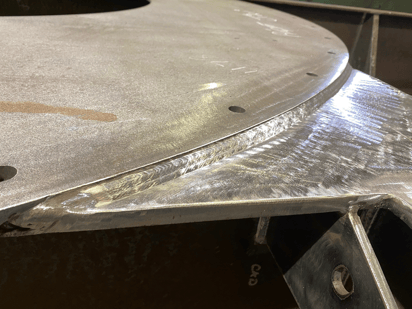Share this
How Many Different Types of Nickel Alloy Plates Are There, And Their Unique Composition
by Therser UK on 16-Oct-2023 13:17:28
Nickel alloys are known for their excellent corrosion resistance, high-temperature strength, and other specialized properties. There are many different types of nickel alloy plates, each with its unique composition and characteristics. Here are some common nickel alloy plates:
-
Nickel 200/201: Pure nickel (Nickel 200) and its low-carbon variant (Nickel 201) are highly corrosion-resistant and suitable for a wide range of applications, including chemical processing.
-
Monel 400: This alloy contains approximately 67% nickel, along with copper and small amounts of iron and other elements. It's known for its corrosion resistance and excellent mechanical properties, making it suitable for marine and chemical processing applications.
-
Inconel 600: Inconel 600 consists of nickel, chromium, and iron. It's highly resistant to heat and corrosion and is often used in applications that involve high temperatures and aggressive environments.
-
Inconel 625: With nickel, chromium, and molybdenum as its primary components, Inconel 625 exhibits excellent resistance to corrosion and is often used in chemical processing and aerospace applications.
- Incoloy 330): Alloy 330 is a nickel-iron-chromium alloy with high resistance to carburization, thermal shock, and oxidation at elevated temperatures. It contains significant amounts of nickel, chromium, and iron, making it suitable for applications where exposure to high temperatures is common, such as in industrial heating processes and furnaces.
-
Incoloy 800/800H/800HT: These nickel-iron-chromium alloys offer high-temperature strength and corrosion resistance, making them suitable for applications like heat exchangers and furnace components.

-
Hastelloy C276: Composed of nickel, molybdenum, and chromium, Hastelloy C276 provides excellent resistance to corrosion in harsh environments, particularly in chemical processing and pollution control.
-
Alloy 20 (Carpenter 20): This alloy contains nickel, chromium, and molybdenum and is highly resistant to sulfuric acid and other aggressive chemicals. It's commonly used in the chemical industry.
-
Monel K-500: An age-hardenable nickel-copper alloy with improved mechanical properties compared to Monel 400. It's used in marine and chemical processing applications.
-
Inconel 718: Featuring nickel, chromium, and molybdenum, Inconel 718 offers excellent high-temperature strength and is commonly used in aerospace and gas turbine components.
-
Alloy 625: Similar to Inconel 625, this alloy is known for its excellent corrosion resistance and high-temperature properties.
-
Nimonic Alloys: These alloys are composed primarily of nickel, with other elements like chromium, cobalt, and aluminum. They are used in high-temperature applications such as gas turbines and jet engines.
-
Waspaloy: Waspaloy is a high-strength nickel-based alloy that offers good corrosion resistance and is often used in aerospace and gas turbine components.
These are just a few examples of the many nickel alloy plates available. The choice of alloy depends on the specific application's requirements, such as corrosion resistance, high-temperature strength, and mechanical properties.
Therser UK
Share this
- Company News (90)
- Battery Materials (41)
- kiln (37)
- fabrication (29)
- Alloy (27)
- Furnace (27)
- Welding (16)
- Industrial Kilns (15)
- Battery (13)
- Ceramic Kilns (13)
- Processes (13)
- alloy fabrication (13)
- Shuttle Kilns (12)
- RTO’s (11)
- Vacancies (11)
- Hydrogen (10)
- Therser UK (9)
- Tunnel Kiln (9)
- Refractory (8)
- Therser (8)
- Wellman Furnaces (8)
- Brickwork (7)
- Case Studies (7)
- Afterburners (6)
- Fibre Lining (6)
- electric (6)
- Almor Wellman (5)
- thermal engineers (5)
- Biochar (4)
- Exhibition (4)
- Pyrolysis (4)
- Servicing (4)
- Spares (4)
- heat treatment (4)
- History (3)
- Ceramics Uk (2)
- Combustion Control Upgrades (2)
- Nitrogen (2)
- Temperature Control Rings (2)
- gas (2)
- Certificates (1)
- Instrumentation (1)
- MMC (1)
- RHK (1)
- Roller Hearth Kiln (1)
- Test Trials (1)
- aerospace (1)
- analyser (1)
- elec (1)
- oxygen (1)
- vans (1)
- September 2025 (2)
- May 2025 (2)
- March 2025 (1)
- February 2025 (2)
- January 2025 (5)
- December 2024 (5)
- November 2024 (7)
- October 2024 (5)
- September 2024 (4)
- August 2024 (14)
- July 2024 (13)
- June 2024 (2)
- May 2024 (5)
- April 2024 (13)
- March 2024 (8)
- February 2024 (12)
- January 2024 (14)
- December 2023 (6)
- November 2023 (12)
- October 2023 (24)
- September 2023 (11)
- August 2023 (11)
- July 2023 (9)
- June 2023 (15)
- May 2023 (53)
- April 2023 (5)
- March 2023 (6)
- February 2023 (7)
- January 2023 (3)
- December 2022 (8)
- November 2022 (5)
- October 2022 (11)
- September 2022 (1)
- August 2022 (2)
- July 2022 (1)
- June 2022 (2)
- May 2022 (1)
- March 2022 (1)
- February 2022 (1)
- January 2022 (1)
- December 2021 (3)
- October 2021 (1)
- August 2021 (1)
- June 2021 (1)
- May 2021 (4)
- April 2021 (2)
- March 2021 (4)
- February 2021 (2)
- December 2020 (3)
- November 2020 (1)
- September 2020 (3)
- May 2020 (1)
- April 2020 (2)
- March 2020 (1)
- January 2020 (1)
- December 2019 (1)
- July 2019 (2)
- June 2019 (1)
- April 2019 (2)
- March 2019 (3)
- February 2019 (4)
- December 2018 (1)
- November 2018 (1)
- September 2018 (2)
- August 2018 (1)
- July 2018 (1)
- May 2018 (3)
- April 2018 (1)
- February 2018 (3)
- January 2018 (2)
- December 2017 (3)
- November 2017 (1)
- October 2017 (2)
- September 2017 (4)
- August 2017 (1)
- July 2017 (2)
- June 2017 (2)
- May 2017 (3)
- April 2017 (3)

